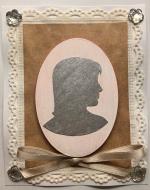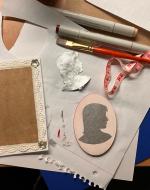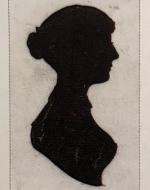Created by Tess Gordon on Wed, 11/15/2023 - 18:31
Description:
Silhouettes were an affordable and popular personal memento during the Regency era that one could keep for themselves or give to a loved one. They capture a likeness of the person pictured while still remaining somewhat mysterious. Of Jane Austen's family, we have detailed portraits of most of her brothers yet only sparce and vague depictions of her and her sister. Austen is the most historically significant member of her family though, because of her gender, she was not deemed important enough for an expensive portrait. One of the only images that exists of Austen is a silhouette (the other being a rough sketch made by her sister) that isn't even authenticated. This silhouette was Austen's sole public depiction as she remained anonymous, signing her work with only the cryptic words, 'by a lady.' During this period of time, women's opinions were practically invisible – much of their value was placed on their appearances. By removing this aspect of her public identity, Austen asserted herself as a force greater than the constraints of her gender. As readers of her work today, we know more about Austen’s personal life, but for the most part, we must base our knowledge on her writing. In this way, the silhouette we believe to be Austen presents a powerful symbol of her protest against gendered limitations, a message that still rings true today. Her brothers may have more physically accurate portraits, but it is Austen's prolific writing that has perservered through time. For my COVE project, I wanted to recreate a Recency era silhouette using an image of myself, thus placing myself in this historical context. Through my silhouette, I wanted to convey as much as I could about myself while still staying true to the mystery of the format – prompting me to grapple with the conflicting ideas of invisibility and expression that Austen herself faced.
Regency-style Self-Portrait Silhouette, Crafted by Tess Gordon, 2023. The first image in my exhibit is my finished silhouette. Because this form of portraiture is so simple, only those who know me well would be able to see the resemblance. In a way, I believe this makes the sentiment even more intimate when it is given as a gift. In the Regency era, gift giving was an important and common practice in relationships, though to be appropriate, content and context meant everything. If I were being courted by someone, it would not have been socially acceptable to give them a portrait of myself until we were engaged or married. Restraint and modesty were key until a relationship became solid; the prospect of social ruin was far too great a risk. For example, Frank Churchill gifts Jane Fairfax a piano in Emma, which causes outsiders to be suspicious of the donor. Even a lock of hair, a more common gift, could be misinterpreted. This is seen in the scandal between Willoughby and Marianne Dashwood in Sense and Sensibility, where young Margaret Dashwood reports that she witnesses him cut off a lock of her sister’s hair, which must mean an engagement. We soon learn that Willoughby has been leading Marianne on and gets engaged to another, more wealthy, woman. If it were not for Colonel Brandon, Marianne may not have had another chance to marry, as she is considered ruined by her previous romance. It would be a much safer bet to gift my silhouette portrait to a family member, like a sibling who is moving out of the family home for marriage. Of course, romantic relationships vary case to case, so it’s possible that this gift could have been well received in certain circumstances; however, I would not have taken any chances. To me, the mystery of a silhouette is much more suited for someone who intimately knows the person depicted. On the outside, a silhouette seems vague and abstract, but it means something completely different when one has a connection to the person behind the outline.
Process of Creating my Self-Portrait, Crafted by Tess Gordon, 2023. This second image captures my critical crafting process. I knew I wanted to place myself in the Regency era context and produce a self-portrait to discover what this might have meant to me. During our time at the IdeaLab, I began by painting an oval piece of wood white. I knew I wanted to put a twist on the traditional black and white format of silhouettes, so I did some research on color palettes. I noted that many muted colors were depicted, nothing too bright or flashy. My next step was to take an image of my profile, which I then traced from my computer onto a piece of paper to make a stencil. I decided to paint the silhouette silver because I wanted something bold, but still fitting for the period. Silver was not a commercial color then, but it is elegant and reminds me of jewelry. I used a light pink marker to subtly color the white background on the wood because many images I saw in my research pictured blush pinks. During a time where appearances were everything, picking the right colors was important to my process. With the cardstock silhouette cutout glued to the wood, I started to brainstorm the background frame. Lace was very popular in clothing during this time period, so I wanted to incorporate that material somehow. I decided on neutral brown paper to compliment the wood and provide contrast to the lighter colors. I measured out the dimensions and glued the lace to the back of the brown paper, then glued that to white cardstock. It proved more difficult than I realized to put these different materials together, so I used books to flatten them out during the drying process. Once dried, I glued the remaining components together and added some finishing touches. The rhinestone stickers in the corners and the bow serve to decorate the border and incorporate more of my own personal taste. Both these aspects are a compromise that fit the Regency aesthetic and reflect my own aesthetic.
Possible Silhouette of Jane Austen, artist unknown, 4 in. x 3 1/8 in. (102 mm x 80 mm). The United Kingdom's National Portrait Gallery (NPG) currently owns this piece, dating it to around 1800-1815. Increasing the mystery of the renowned author, the NPG labels this portrait as "Possibly Jane Austen." In the description, we learn that Mansfield Park, upon publication in 1814, included a silhouette in the back and that the second volume had inscribed in it "L'aimable Jane." Although we do not have confirmation that this portrait is indeed Jane Austen, we can assume that it must be. Not only is this one of the sole two likenesses that we have of Jane Austen, but we also aren't even completely sure that it is her. To her readers, Jane Austen’s silhouette reveals very little, but to someone like her sister, Cassandra, it might have represented much more. During the time when she was writing, this portrait allowed her to indicate to her audience that they were reading the work of a woman, without prompting them to base their opinions on her appearance. In this way, Austen challenged the invisibility of women by redirecting what aspect of herself society could focus on.
Overall, this project allowed me to think about what my life might have looked like if I lived in Jane Austen’s time, especially about what decisions I could have made in such a harshly judgmental society. The portrait I created is very personal to me and would have been considered an intimate and telling gift. Although it is mysterious, it expresses some of my tastes. Because I don’t have a large body of writing to indicate who I am like Austen does, this project allowed me to explore small scale ways that I might express myself in a society where women had only superficial value.
Copyright:
Associated Place(s)
Part of Group:
Featured in Exhibit:
Artist:
- Tess Gordon




